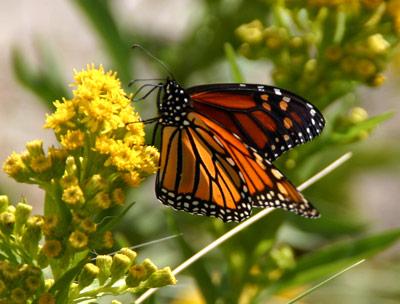Nature Notes: A Great Migration

This past week saw the beginning of what could promise to be one of the greatest monarch butterfly migrations in a long time. The wind was gentle and blowing out of the southwest and south-southwest on most days after Tropical Storm Irene’s passage. At this time of year the monarchs fresh out of their chrysalises are heading south and southwest, into the wind, and following the shoreline. Since before the year 2000 here on eastern Long Island we have seen very little in the way of monarchs come the end of summer.
These brightly colored orange and black butterflies count on two things when they get here after a long flight up in the late spring, not too much inclement weather, especially when they are emerging from their cocoons come August, and a good growing season for milkweeds.
It was a good year for milkweeds on the East End. Common milkweeds, butterfly milkweeds, and swamp milkweeds grew well and flowered well. The monarch caterpillars emerge from eggs laid by the adults shortly after they arrive here, and the caterpillars gorge themselves on the milky juices that milkweeds produce. The juices are not only nutritious but contain a noxious chemical that the caterpillars incorporate into their flesh. It stays with them through the process of pupation and emergence of fresh adults called imagos.
Monarch caterpillars also feed on dogbanes, which, as the name implies, are poisonous, containing the same noxious chemical but in a more concentrated and slightly different formulation.
Birds such as jays and small hawks that feed on butterflies on occasion learn to avoid the monarch after one bite because of that chemical. They are most unpalatable and consequently, they have little to fear, except for strong winds and running out of food on their long daylight flight down to the mountains in Mexico where they overwinter before breeding and giving rise to a whole new generation of butterflies, which instinctively fly north as soon as they spread their wings. Most songbirds migrate at night when they can navigate by the stars and gravitational forces and avoid the predators like hawks, which migrate during the day. The monarchs are safe to go during the day.
However, they are slow fliers compared to birds and don’t fly more than 10 or 20 miles each day on their way south. The migratory flights of birds on the other hand can cover hundreds of miles in a 24-hour period if weather conditions are right. Birds store fat and carbohydrates for the long journey; monarchs don’t, they feed on nectar as they go.
That is where the late flowering asters and goldenrods come in, especially the seaside goldenrod, Solidago sempervirens, which grows in the coastal dunes and on the back shores of our marine water bodies including the ocean. Everything was hunky-dory in monarch land until Irene came along. One can’t help notice how the vegetation along the ocean shore and along some of the North Shore bays turned an unattractive brown right after Irene’s blow-by. Thus far, the seaside goldenrods that are just starting to bloom look like they weathered the storm, but it will take a few more weeks before we can know for sure.
Meanwhile, the rest of the wildflower crop is not faring as well as it would have absent a tropical storm’s impact. Thus, it will be a bit of a waiting game to see how these fluttering migrants will fare come the end of September.
